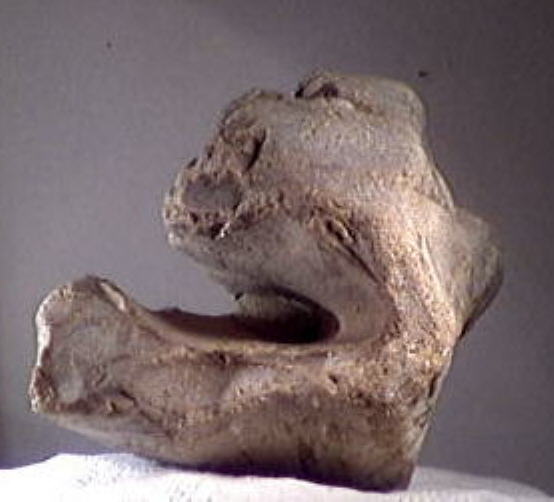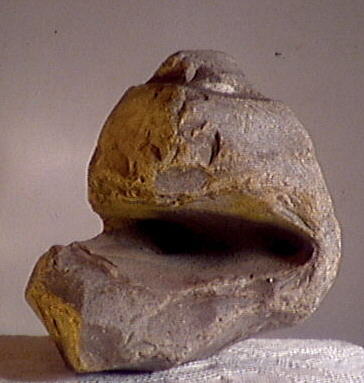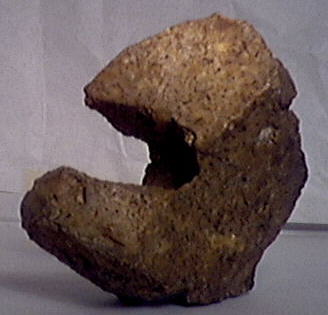
The Man of the Romandato
(right side view)
The richness of prehistoric deposits in Province of Foggia is impressive. Neolithic villages identified by aerial photograph are approximately one thousand (up to 25 years ago); Paleolithic deposits are more, but mostly of the finds that have yielded, and continue to yield, are in secondary layers. Among these deposits, one of the most important is the mouth of the Romandato Creek (about 3 km. west from Rodi Garganico). Here are flint industries of the whole Lower Paleolithic, both on pebble and on flake. The most ancient artifacts on pebble are very flowed. Paleolithic sculptures are found as well.
Here I found the biggest sculpture that I introduce here (Fig. 1). This creek for over thirty years has periodically been object of my research, and I have always found it dry. In summer the mouth of the Romandato Creek became a parking for the cars of bathers; while all year round it became a road for caterpillars and vehicles of local farmers. The landscape is beautiful, as, in addition to the sea, there are big plants of prickly pears, but imagine my suffering in seeing such a heritage of Paleolithic artifacts trampled by cars.
The alluvial deposits of this type, for decades now, are neglected by scientific research, as they don't say anything anymore, even if they can still give quality tools; but, after all, it can be understood since for 200 years tools have been researched in surface deposits. It is right that finds are sought "in situ", i.e. deposits where, along with tools, we can also find remains of animals of which the man ate, and many other data; and, when we are lucky, also some human remains.
It is different for the art, as the art was not in the places of dwelling (generally the deposits "in situ"), but in worship places. Therefore, the sculptures, and whichever other stone artifact, but also normal pebbles, have been transported randomly by the alluviums from worship places (which we don't know), and from the surrounding zones, like at the mouth of the Romandato Creek. For this, the alluvial deposits are still important to find sculptures of the Lower Paleolithic.
Another important deposit, where I have found the smallest sculpture (Fig. 2) is in Spinacchi, between Vico Garganico and Ischitella. From these mountains the spectacle is equally exciting, in how much, besides the beauty of the mountains, an immense blue sea can be admired.
The Paleolithic artifacts found at these altitudes are intact, i.e. not damaged by alluvial tumbling, since in the last interglacial the sea did not rise to that level.
Description of the works
The Romandato Man (Fig. 1) is a flint sculpture representing a human head with opened wide mouth. No neck. Well represented the jaw, with absence of chin. It is devoid of forehead. Dimensions: height cm. 23.5, length cm. 29, width cm. 18.5 (these are the maximum dimensions, as there are narrower parts). The mouth is wide cm. 17.0 inside, and cm. 7 outside; it is high cm. 6 on the right, and cm. 2 on the left; it is deep cm. 11. It is in flint. Weight kg. 11,5. At the bottom of the mouth there are incrustations of shellfish, indicating an ancient staying at sea. It is lightly tumbled by alluvial rolling, and sea waves, but not disfigured for deletion of workmanship traces. Before the curve of the cranial cap there are two removals, shaping an enlarged "V", which could have been the representation of the eyes.

The Romandato Man
(semi-frontal front view)
The Romandato Man
(left side view)

The Romandato Man
(frontal view)

The Spinacchi Man
(left side view)

The Spinacchi Man
(semi-frontal front view)

The Spinacchi Man
(semi-frontal right view)

The Man of Mouthiers
(left side view)

The Man of Mouthiers
(right side view)
These three sculptures Fig. 1,2,3) are rough-hewn with removal of large flakes in a very decisive way. The technique of working is similar to that one used in order to produce tools in the Acheulean. I add a short explanation for the profane. The lithic industries are the totality of the types of tools and are divided in two types: artifacts on pebble and artifacts on flake. In Gargano only small and large pebbles were used. For artifacts on pebble generally we mean those that are held, and are pointed (bi-faces ); while for artifacts on flake, is meant some flint flakes, that were not held, but kept by two or three fingers, in order to cut or to scrape skins, meat, wood, etc.. These flakes were obtained from pebbles.
The technique of working of the sculptures is divided in two phases. The first one is the roughing, which in tools is equivalent to obtaining lamellae from a pebble; the second one is the shaping, in order to evidence some particulars, that is equivalent to the retouching in the lamellae, or in order to make pointed the tools on pebble.
The processing differences between tool making and sculpture vary in every Paleolithic phase, according to the various cultural stages; but staying in the Acheulean (with coupled Clactonian) the differences generally are three: 1) in the blades the touches to make them sharp are only on one side; 2) in the tools that are held the removals are on two sides; 3) in the lithic sculptures the removals are on every side (high, low, right, left), even if the representations are never all round.
It's important take into account that almost all lithic sculptures of the lower and middle Paleolithic have anthropomorphic and zoomorphic semi-frontal representations, and that, in most of these sculptures, the part not occupied by the depiction was found made, i.e. the stone was used as it was.
In the Romandato Man (Fig. 1), in the Spinacchi Man (Fig. 2) and in the Man of Mouthiers (Fig.3), the opened wide mouth has been obtained from cavities yet in the stone (of natural origin), that the man has used, exactly like he used in other sculptures, or in some tools, some parts already ready.
Cultural attribution
The three sculptures (Fig. 1,2,3) have been found at surface stations, which are generally secondary positions. Their cultural attribution is the evolved Acheulean, but it could be the Clactonian, or even the evolved Acheulean - Clactonian and conjointly. But it is well to clarify these doubts.
I add a short explanation for the profane: the denomination of the cultural periods of the Paleolithic refers to the discoveries of the first tools from which the typology originated. The Acheulean denomination was created in 1873 by G. de Mortillet, and derives from the discoveries of bi-faces at Saint-Acheul in the ancient alluviums of the Somme Valley (Northern France); while the Clactonian is constituted from tools on flake (without bi-faces) discovered in layers at Clacton-on-Sea, County of Essex (England).
Since the cultural attribution of the sculptures is based on the cultural attribution of the tools, that have been most studied, and with which they have in common the working technique, I begin my description from the Acheulean and the bi-faces (formerly known as amygdales).
The bi-faces are pointed stone tools that are held, and are multi-purpose, that is, they could be used to hit an adversary, but also to cut or scrape. The name amygdale (the first discoveries in scientific key date back to the late '700) is due to the shape, which is similar to an almond.
In the second half of the twentieth century the amygdales took the name of "bi-faces", as they are sharp on both sides at the tip. The Clactonian, on the other hand, is made up of a flake industry. These tools were used for domestic purposes, and certainly not for hunting or battle, for which wooden spears were used, and one has been found. The pebble industries appear to have African origin, while the flake industries appear to have Asian origin.
In the Gargano the two types (Acheulean and Clactonian) are combined.
The union of two different peoples, with their own cultural heritage, results in a doubling of cultural heritage.
Both the Acheulean and the Clactonian in the Gargano lasted a long time, given that the most ancient artifacts are flowed, and the most recent less, and this is due to the action of the sea waves in the interglacial periods. For this reason, the two sculptures (Fig. 1 and 2) can be Acheulean, Clactonian or Acheulean-Clactonian. However, my cultural attribution is also based on affinity with other finds from various areas of Europe. That is, these sculptures do not have a cultural attribution by type, like others known, as they are two heads with opened wide mouth of a type up to now unknown.Their attribution is based on the quality of the processing technique, and on the quality of the type of representation, which is better than that of previous periods, but inferior than that of subsequent periods.
The dating is approximately 350,000 years ago. (This is based on research on the industries of the Gargano published in the
Interpretation of the physical aspect.
In my opinion the three sculptures (Fig. 1, 2, 3) represent the head of Homo erectus with the opened wide mouth, and represent the scream of Homo erectus. Since those who are interested in art generally are not interested in paleoanthropology, I add a brief description of Homo Erectus. Throughout the 1900s, the finds of Homo erectus consisted of parts of skulls, such as jaws, skullcaps, parietals, etc. , and not even an intact skull; rare are the finds of other parts of the skeleton. These finds have old denominations: Euranthropus, Sinanthropus, Atlanthropus. The complete shape of these skulls is known only from reconstructions made by paleoanthropologists. However, the reader can read up on paleoanthropology books. In my opinion Homo erectus is still a ghost for science. Its identity can be placed between Homo habilis and the Neanderthalians. It is true that there are Pre-sapiens and Pre-Neanderthalians, but their appearance is already modern. These three sculptures have been attributed as representations of Homo erectus for the shape of the jaw with absence of chin, and for the absence of forehead, that correspond to the skeletal remains found of Euranthropus, Sinanthropus, Atlanthropus, but also to all the other components of the technique processing, which give a chronological position, as happens in the typology of tools.
Cult of the dead connected to the skull only.
The remains of Homo erectus are almost all parts of skulls, so much so that authoritative scholars such as A.C.Blanc, S.Sergi, H.V.Vallois and others, in the first half of the 20th century, published their studies on a cult of the dead in the lower Paleolithic , linked to the conservation of the skull, which persists in the ethnography of Homo sapiens sapiens.
In fact, in ethnography we find a cult connected to the skull, with or without a jaw, and a cult connected to the jaw of the deceased only. These skulls, or parts, women carry with them: the jaw, or more jaws, hanging from the neck; the skull hanging from the back.
These same lithic sculptures depicting heads without necks fall within the ideological dimension of the skull, that is, the value of the head.
Interpretation of the style.
However rough the sketch-out of the three sculptures may be, to which the style of representation is not extraneous, the content is evident. Both the Man of the Romandato (Fig. 1), the Man of Spinacchi (Fig. 2), and the Man of Mouthiers (Fig. 3) fully represent the scream of Homo erectus.
All sculptures, like any other type of artistic application in the world, and of all times, have a style. That is, a human head can be represented in a different way, in a thousand different ways, according to the style of each people, but it is always understood that it is a human head. This is style, I.e. the language of art.
These three sculptures, which to the profane can hardly appear works of art, already have a style.
A profane could consider the styles of these three sculptures at the origin of the style, instead the style already existed with the oldest sculptures. I remember that the term "style" has many meanings today, as does the term "art" (recently in New York some artists gathered to find a new name for the term "art", which they no longer like, but there aren't any successful).
I adopt the term style, because I have not yet committed myself to inventing another name, however, it does not seem such an important problem to me.
The styles of the three sculptures are similar, but different, also because they are probably not contemporary. Assuming that their cultural attribution can be dated to 350,000 years ago, with the fluctuations that scientific evaluation allows, there could be, between one and the other, even 10,000 years of difference, i.e. the three sculptures could have been made over 30,000 years, if not more (this, provided that the dating of the geologists, which I use, are correct).
Making a summary analysis of the styles, which diversify the three sculptures, we find that the mouth of the Man of the Romandato (Fig. 1) is exaggeratedly wide and deformed, and is linked to a caricatural expressionist style, while the other parts of the head they are relatively proportionate.
Spinacchi's Man (fig. 2) is depicted in a realistic style for the jaw without a chin, but invented for the face, which is depicted laterally.
The Man of Mouthiers (Fig. 3) is depicted in a realistic style, with strong expression.
Historical and etnographic parallelisms.
Sculptures of human heads with the opened mouth are present in the ancient historical civilizations, and generally they are masks.
Other masks with open mouth are present in the wooden sculpture of the equatorial belt of Africa. The most frequent types of these masks are mixed representations of men and animals, that I have defined "humanized animals".
These representations, however, are not representations of a real "scream".
The roar of the lion. .
In the zoomorphic post-Paleolithic art (sculpture, bas-reliefs, paintings) it is very frequent, between the animals, the lion to have the opened wide mouth. This is found in the antiquity near the Sumerians, the Egyptians, the Greeks, the Romans, etc.
The wide-open mouth of the lion represents the roar, which is menacing, and makes man afraid. The representation of a roaring lion has always had a strong impact on the viewer, as it still does today. The lion's roar can be equated with the victory cry for man, at least in artistic depiction. This scream is seen very frequently in movies, and in sports photographs, when the player puts the ball in the net, or wins the race.
However an identification man-lion in the scream and in the roar can be held in account for a study on the rituals of cult of the Acheulean.
The scream of the man.
Men scream in many different circumstances, and in different ways. One of these is the scream used in battle.
It is written history that the ancient Romans used mercenaries from present-day Liguria to go into battle against people from current-day Switzerland, which was made up of Ligurian tribes. At the beginning of the battle, the Ligurian soldiers noticed that their opponents had the same "battle cry" as them, and they stopped.
Conclusion. Each scream has its own meaning. The fight shout must scare the adversary. The shout of victory must unite the group. The shout of desperation can be personal or collective, like the two previous shouts. The representation in the sculpture of the lower Paleolithic of a human head with opened wide mouth represents a scream; I cannot believe that it can represent a yawn, or a song.
The opened wide mouth is also an expression of movement. If we take in examination the wall zoomorphic paintings of the caves of the upper Paleolithic, we find horses, cows, bulls, bison, etc., in two different attitudes. One of these attitudes is movement (running animals), the other is of animals not in movement, that seem dead, and are often represented with legs upwards, so that they seem to wander in the space. These representations of living animals (in movement), and dead animals, correspond to different eras, and also to different meanings.
Same parallelism is worth also between the sculptures of human heads with the opened wide mouth, and those with the mouth closed (or absent) of the lower and middle Paleolithic.
New discoveries of sculptures of this type, and greater historical and ethnographic parallelisms could give further clarifications.
My opinions, and those of people with which I have analyzed these three sculptures with the opened wide mouth, are in agreement in seeing the representation of a scream, that is the scream of the man that has created them:
Copyright©2000-2002 by Paleolithic Art Magazine, all rights reserved.